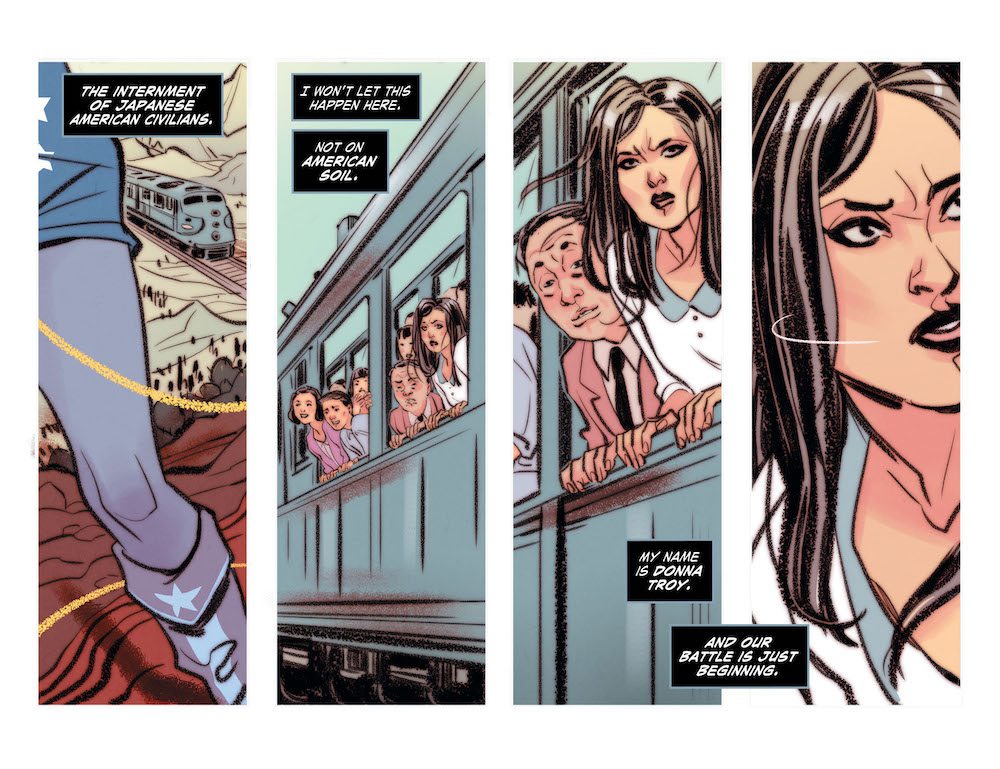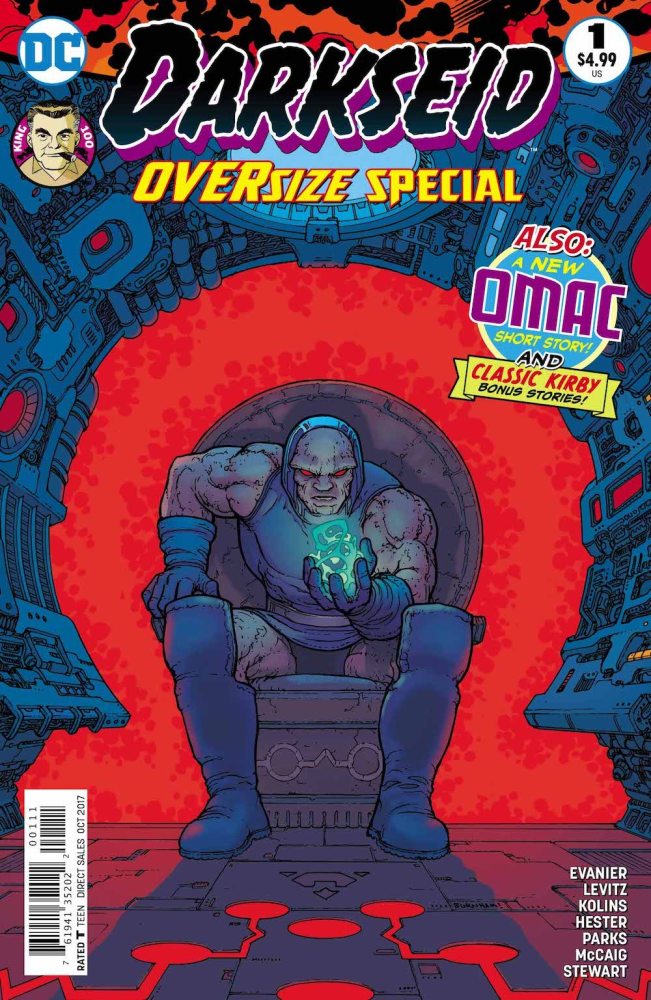
It seems odd that DC Comics is doing more for Jack Kirby’s 100th birthday celebration than Marvel Comics, but given the quality of the Kirby tribute issues from DC, we’re not complaining, at least to DC.
Marvel, oddly, did no major tribute to Jack Kirby save for some house ads, although that may partially be because many of his most iconic creations there are owned by Fox. A far cry from when Mark Waid and the late Mike Wieringo literally made him God years ago in Fantastic Four. (Still, I imagine Marvel could have found a better tribute for Kirby than turning his most iconic creation into a Nazi for a year and smugly arguing with Jewish critics on social media.)
This is the fifth week of August, which also saw Kirby’s 100th on August 28, and it’s s small week overall but one that includes the two Kirby tribute comics, including one by longtime Kirby assistant Mark Evanier, who wrote a terrific biography of Kirby. That’s the Darkseid Oversized Special #1. The Black Racer Oversized Special #1, the second tribute issue, is notable for the creators involved: Denys Cowan and Reginald Hudlin.
Plus, reviews of annuals of Supergirl, Red Hood & the Outlaws; and the regular issues: Justice League of America #13, All-Star Batman #13, Wonder Woman #29, and Bombshells United #1, the return of the DC Bombshells.
Warning: Major Spoilers for all of today’s DC Comics.
Spotlight: The Kirby Tribute Issues
Darkseid Oversized Special #1 – Mark Evanier, Paul Levitz, Writers; Scott Kolins, Artist; Phil Hester, Penciller; Ande Parks, Inker; Dave McGaig, Dave Stewart, Colorist
Ray – 8.5/10
Corrina: At the Bottom of the Rung In Apokalips
Ray: The first of two Jack Kirby one-shots to wrap up the centennial event, this one turns the focus on his most iconic creation and the likely eventual big bad of both the DC Cinematic Universe and the upcoming third season of Young Justice – Darkseid. But although this is one of the best Darkseid stories I’ve read in a while, it’s not really his story. It’s the story of the countless people suffering under his boot – and in this tale by Evanier and Kolins, the story of a few brave rebels who have managed to survive against all odds. A trio of teenagers who escaped from Granny Goodness’ horrific “academy”, they’re now pursued by all of Apokalips, as Darkseid is willing to raze the entire slum to find the few who defied him. Even as their bond frays, the trio – and their leader, Makayla, in particular – become icons of the resistance, something that clearly worries Darkseid.
This is a Darkseid we really haven’t seen before. He’s evil, he’s terrifying, but he’s also scared. Evanier works a strange sense of honor into him, as is seen in his treatment of the escapee who quickly gives away his friends’ locations, and his treatment of Makayla when he captures her. While it’s clearly a cosmic adventure story, it’s also a tale that I think a lot of people will relate to, a tale of rebellion against evil and dictatorship, and how one person can trigger a revolution. We’ve seen stories on Apokalips in this vein before, but never from this perspective. The backup, by Levitz and Hester, focuses on OMAC as he also takes on an incredibly powerful enemy – in this case, Brother Eye. It’s got some great visuals, as Hester has always been a master, but unlike the first story, the exciting battles really lack any emotional power, and it feels much more like a story for those familiar with OMAC. The issue ends with two Kirby shorts – one a Young Gods tale, and the other a strange sci-fi story from the archives.

Corrina: While I’ve enjoyed these original stories immensely, it’s been the Kirby stories that I’ve been most eager to read. There’s just something immersive about his style that pulls me in, no matter how odd the concept. Re-reading his tales makes me appreciate all over again his influence on the later greats of comics, like the sense of wonder and weirdness in Grant Morrison’s work, or the tragic heroism that’s present in Darwyn Cooke’s DC: The New Frontier.
But, yes, the tribute stories recapture that Kirby magic well. Darkseid is usually written as a one-note overwhelming force for evil and yet here, we see depths to that person, with the insight that a tyrant who insists on so much control must be afraid of something. But, as Ray said, it’s the rebels that tug at the heartstrings, people caught in a situation with no hope who insist that if it doesn’t exist, they’ll create it. That’s a lovely concept and a great tribute to the creator of Captain America, the most hopeful of heroes.
The Black Racer Oversized Special #1 – Reginald Hudlin, Writer; Denys Cowan, Ryan Benjamin, Pencillers; Bill Sienkiewicz, Richard Friend, Inkers; Jeromy Cox, Colorist
Ray – 8.5/10
Corrina: You Can’t Outrun Yourself
Ray: Only one story in this final Jack Kirby one shot, save the reprinted backups, but it delivers. Reginald Hudlin is a name in comics that’s been rather controversial (his Black Panther run introduced Shuri, but was also plagued with many complaints about characterization), but on this one-shot, he nails it. While it’s titled after the New God of Death, he’s not actually the star here. That’s Shilo Norman, the second Mister Miracle and the protege of Scott Free, who was raised to prominence in the Seven Soldiers mini by Grant Morrison. While Scott Free is clearly getting his moment in the sun now, it’s good to see Norman get some attention too. This issue is essentially one big, epic chase sequence, as escape artist Shiloh is about to engage in his most daring escape yet – as part of a bed with a Trumpian businessman, and with the help of a shady fellow magician.
While he’s planned everything about his escape from the missile out to a T, he wasn’t counting on the appearance of the Black Racer – whose appearance means you’re about to die, and there is no escape. The ensuing chase takes Shiloh through time and space, as he attempts to stay ahead of death and figure out what’s going to kill him. The main story is spliced with a flashback to the origin to the Black Racer – whose human alter ego was paralyzed in an act of gang violence upon returning home from war. Although the Racer doesn’t say much, Hudlin manages to give him some genuine personality. The ending and reveal feels a bit abrupt, but it’s an epic thrill ride of a story that is a proper tribute to Kirby. The Kirby reprint this issue also features the Black Racer, in a race with fellow New God Fastbak, and is a good representation of Kirby’s classic sci-fi adventures.

Corrina: Cowyn’s art brings a great sense of atmosphere to the main tale, grounding it in human sadness, while at the same time offering that epic chase through time and space, with a tribute here and there to other Kirby’s properties, like Kamandi. It should be a slight story and yet the emotions evoked, especially around the meaning of life and death and when one should succumb to death and when one should keep fighting, is going to make this a story I remember for a long time.
As I was reading Fastbak vs. the Black Racer in Kirby’s original tale, I was struck by his sense of pacing. There is not a wasted movement, not a wasted panel or page. In fact, one could create whole stories from just one panel of Kirby’s work.
Evanier has an essay in this issue where he speaks of Kirby’s commitment to expanding the voices in comics beyond what the medium was doing at the time, and that was an inspiration for his creation of the Black Panther. Given our current political situation, it made me wonder what Kirby would be creating right now.
Pretty sure it would be close to people punching Nazis.

Grade A Issues: Ratings 9-10
Justice League of America #13 – Steve Orlando, Writer; Ivan Reis, Artist; Julio Ferreira, Inker; Marcelo Maiolo, Colorist
Ray – 9/10
Corrina: Battle in the Microverse!
Ray: After several character-driven arcs, Justice League of America has ascended into a full-on blockbuster story arc with the Microverse plot that will reveal the fate of Ray Palmer. Last issue ended with the team – sans a few members like Black Canary and The Ray, who are back on Earth and have a filler storyline involving a battle with Afterthought – arriving in the Microverse and being saved from some monsters by a mystery figure with Ray Palmer’s belt. This is revealed to be Preon, a survivor of a doomed species who worked with Palmer and his alien partner, Aron Aut. However, they’ve gone missing now and she’s carrying on their work. She explains that the Microverse is falling apart and threatens to take the rest of the universe with it, and escorts them to the populated area of this mysterious land.
What’s interesting is that there’s a thriving civilization in the Microverse – although thriving might not be the right term. It’s being devastated by Quantum lightning, which affects matter and alters it in horrific ways. There’s one scene that illustrates this, and despite nothing graphic being shown, it’s incredibly disturbing. It’s also going to affect one member of the team in upcoming issues, it seems. There’s a mysterious wizard who has shrunk even beyond the Microverse, and has the power to potentially help but isn’t getting involved. And then there’s the appearance of Aron Aut, who knows secrets about Palmer and Preon and sets off a tense showdown to end the issue. But really, this is Ryan Choi’s story to shine, and next issue seems like it’ll be his spotlight as he pushes his powers beyond the impossible. Best story arc in this title yet.
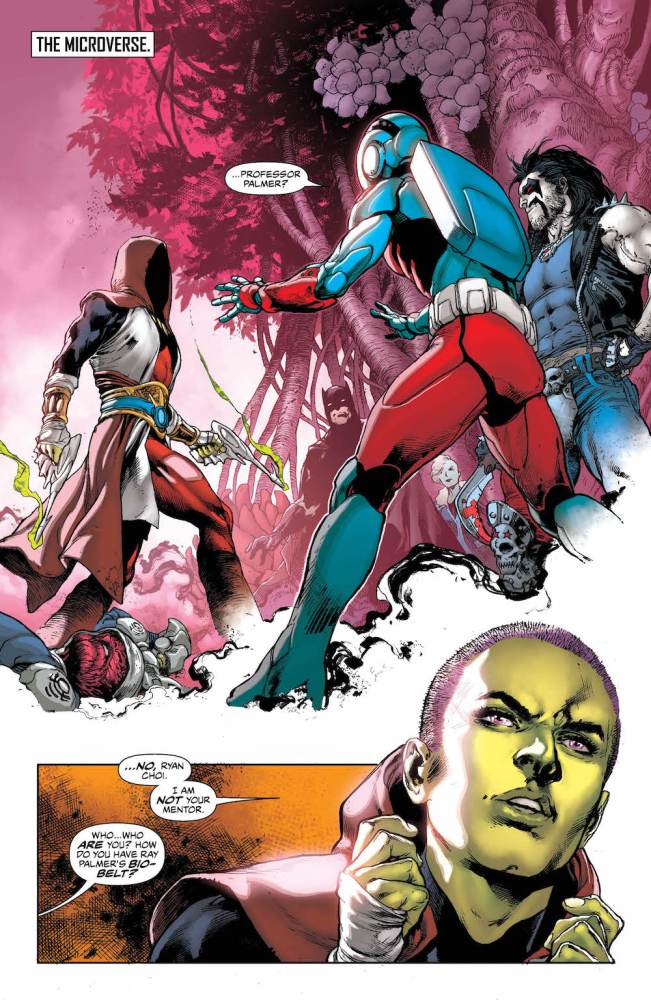
Corrina: I’m not certain it’s the best story arc so far but I’m enjoying the heck out of it, especially for Ryan Choi pushing himself beyond his limits because of his devotion to his teammates and to his mentor, Palmer. Orlando has made this more than a simple rescue mission of one person, as the entire world itself is under peril. (Is this another symptom of the Dark Metal universe leaking through? That seemed implied.)
What the strangeness of the Microverse also does is bring Batman down to a human level. He’s unfamiliar with anything in this world and so, for once, he doesn’t have all the answers and you can tell he’s genuinely frustrated that he’s not certain who i a friend and who’s an enemy. (I’m not certain either.) Reis is doing terrific work with a huge cast and an unfamiliar landscape, putting the reader in the middle of the action.
And while I want more Black Canary in this title, I’m thrilled to see more glimpses of her personality in her talk with Ray. Enjoying this title quite a bit.
All-Star Batman #13 – Scott Snyder, Rafael Albuquerque, Rafael Scavone, Writers; Rafael Albuquerque, Sebastian Fiumara, Artists; Cris Peter, Trish Mulvhill, Colorists
Ray – 9/10
Corrina: Fathers & Sons
Ray: The penultimate issue of this series lets Alfred shine in an epic adventure that shines some light on the darkest moments of his past and provides a great foundation for his odd, often contentious but ultimately loving relationship with Bruce. And what better place for that story to play out than in the middle of a high-speed international espionage drama? The issue opens with a great one-page segment where Alfred imagines how their story will end, decades down the line, and then dovetails into a phenomenal parachuting segment that shows off Alfred’s willingness to sacrifice himself for his son – and Bruce’s stubborn determination to get both of them out alive. A bit of a side note – it’s great to see Alfred refer to Bruce as his son, but it’s a bit odd that he doesn’t mention his biological daughter much. Snyder’s the one who brought her back!
Equally as interesting is the flashbacks to Alfred’s military days, and his brutal initiation by the mysterious Briar. Briar could have easily been written as a one-note villain, but he’s given a charm and his own personal tragedies – which make it all the more horrific once the final stage of his initiation is revealed, as well as making his personal plans for Bruce’s engine more shocking. This is how you build a villain. The solicits for this arc made it look like Alfred might have some shocking secret that would undermine his relationship with Bruce, but that’s not the case. Rather the opposite – this arc drives home how this is arguably the most important link to humanity in Batman’s life. This may be Snyder’s final solo Batman story for a while, but he’s going out with a bang. The backup, as always, is serviceable but pales compared to the main arc.
Corrina: I enjoyed this issue, perhaps not as much as Ray did, though. I was thrown by the opening segment, wondering if that was a flashback or flashforward…and so had to stop and sort out how it fit in and when I have to stop and ponder something rather than being drawn into the storyverse, that means what was on the page wasn’t clear enough, at least to me.
But, of course, it’s Alfred’s emotions that are front and center in this issue and, really, in this arc and that’s the draw. Readers have been treated to Alfred’s unique point of view on Batman’s world which is the true charm of this arc, especially since Alfred is full of all the worry and guilt of a parent. That point of view makes me put aside my questions. For instance, I’d have liked to see how much good Briar’s Black Knights accomplished as a counterpoint to his terror at having trained men who go out and die. He must have believed in his goal, yes? So who did they save? What did they accomplish for the good? Answering that would help me sort out what Briar hopes to accomplish with his villainy. (I assume he’s gone villain because Alfred never became the Black Knight and instead fought Briar to save the elder Pennyworth. Or something.) Ah, Alfred. I’ll miss your snark after this arc is over.
Supergirl Annual #1 – Steve Orlando, Writer; Steve Pugh, Artist; Michael Atiyeh, Colorist
Ray – 9/10
Corrina: Fatal Five Kinda…Not Fatal?
Ray: Both of the annuals this week are essentially like double-sized issues of the main series – same writers, and this one is the second part of the ongoing storyline – and so the quality of the annual is pretty consistent with the main series. For Supergirl, that’s very good news, as this new take on the “Supergirl Revenge Squad” (a concept first invented by Sterling Gates, before his run was cut short by a writer who lasted half an issue) is probably the best arc in the series so far. This issue has a huge scale, as the villains attack Kara from every angle, each with their own agenda, and all of Kara’s allies unite to defend her. The issue starts with Kara battling Solomon Grundy as her powers rage out of control, and the battle is joined by Indigo – who proceeds to expose that Kara is keeping her father in the DEO and turns the public against her.
Indigo is an intriguing villain, pretending to be a hero while having her own agenda. Emerald Empress, meanwhile, is off tormenting Cameron Chase and seeking answers to her own dark future, something she blames Supergirl girl. Selena is bedeviling Cat Grant – who unlike most of Supergirl’s friends, is buying into the propaganda. It’s only thanks to Ben Rubel that Cat is able to be brought back over to the side of good. Dr. Veritas, who is a character who was introduced in the Lobdell run but has been put to good use by other writers since, helps save Kara from her out of control powers – although it seems there may be some permanent changes here. We also get some nice little details about Veritas’ personal life. This is a big, epic issue with almost too much going on – certain villains, like Magog, feel pointless – but it works. Orlando pulls in every subplot from his run so far to deliver a genuine blockbuster of an annual.
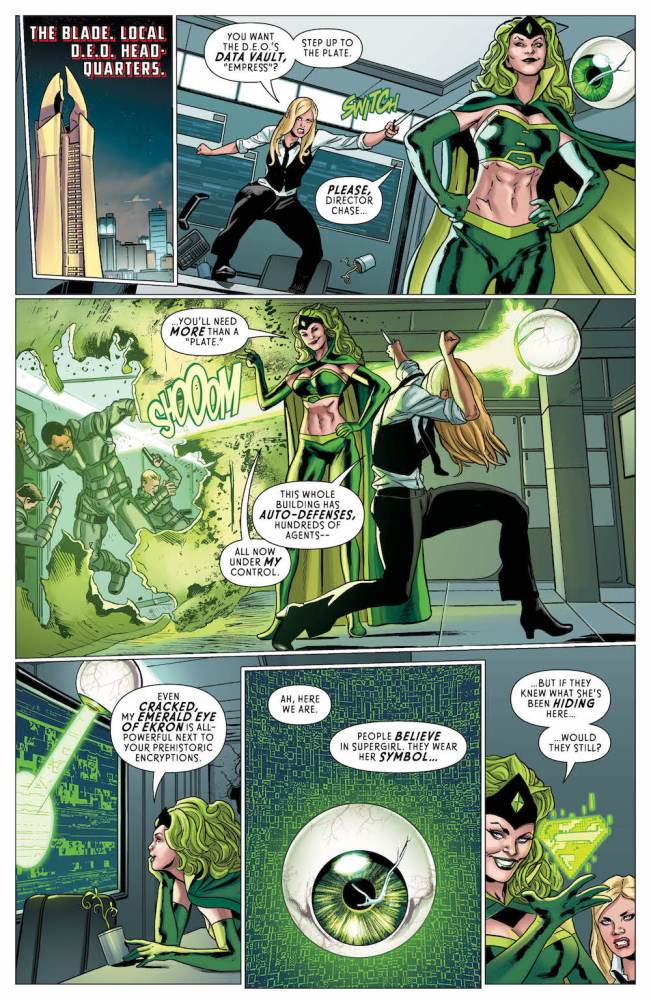
Corrina: Is Indigo pretending though? Empress implied she’s been reprogrammed as a hero, as a distraction and ultimate revenge on Supergirl, by taking away her role? I guess we’ll see but, of all the villains this issue–including the Empress–Indigo is the one that intrigued me the most and the one I’d like to see as a supporting character after this arc is over.
I was less enthused with this issue than Ray. Partly that’s because I hate to see parts of cities be destroyed. It’s a trope that bothers me ever since 9/11 and with what’s happening in Houston, I couldn’t help but wince a bit. Too real, there, though the time of this issue’s release and Hurricane Harvey was certainly not under DC’s control. Perhaps I’m just wishing for stakes that weren’t so realistic, I suppose.
The other part that frustrated me is Indigo’s message to the city about Supergirl and her conversation with her “father.” Instantly, they all turn against her? That’s another trope and I’m not buying anymore either, especially when people are so distrustful of news sources and especially when Supergirl was so visible saving the world. I did love the inclusion of the Danvers and of Cameron Chase. And I look forward to Supergirl kicking the Empress back to the future.
Solid B Issues: Grades 8-9
Bombshells United #1 – Marguerite Bennett, Writer; Marguerite Sauvage, Artist
Ray – 8.5/10
Corrina: Timely Focus on American Racism
Ray: Bombshells relaunches this coming week (the first few chapters are already up on DC’s digital service) and DC was kind enough to give us an advance look at the first print issue. The quality of this creative, socially relevant title has not dimmed a bit, even as it leaves the majority of its cast back in Europe and focuses on Wonder Woman and a new cast of supporting characters. The first volume focused on the evil dark sorcerers of the Third Reich and the cold-blooded mad scientists of the Soviet Union, but the threat in this volume is much closer to home – American paranoia and racism. The issue opens with Marguerite Sauvage’s gorgeous art depicting Wonder Woman’s horror and anger as she finds out that her adopted homeland has begun arresting and imprisoning law-abiding citizens for their ethnic background.
This story allows the title to introduce Diana’s two most iconic sidekicks – Donna Troy, here reimagined as a Japanese-American teenager leading the resistance, and Cassie Sandsmark, here a 1/16th Japanese girl caught up in the roundups. This issue does a great job of establishing the absurdity of the executive order, which caught up Korean-Americans and people like Cassie who didn’t even know they were Japanese. What it doesn’t do, though, is give a name to the evil. Beloved American President FDR is never named, despite this being the biggest stain on his record. Where the issue excels is in its creation of this “biker gang” of teenage girls, now joined by Wonder Woman, as they stand alone against the government’s bigotry. I’m not sure about the decision to make this evil soldier who seeks to assassinate the captives actually Clayface – the reveal sort of comes out of nowhere – but this series is filled with great characters and a story that’s as timely as ever.
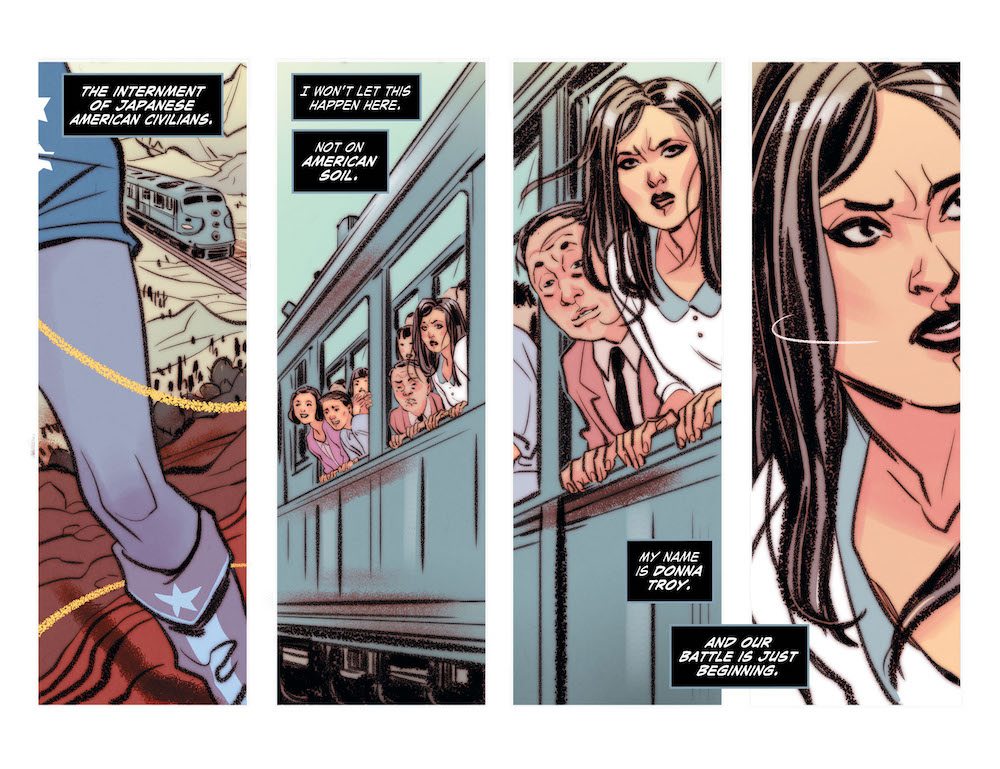
Corrina: Yay, Donna Troy is back and she’s not an evil, soulless brainwashed version of herself, as she was in the regular DC Universe. Not that she would be, in this comic, but still, it just shows how much better female characters tend to be handled in this book than in the main DC Universe. (I’m still not sure what’s going on with Cassie anymore, which is sad. Hey, maybe we can give Bennett a Young Justice book?)
To the plot–the resettlement of American citizens into camps during World War II is still a stain upon our democracy and one that’s a reminder of what can happen when people give into fear. It’s a perfect issue for teenagers to seize on as unfair, as these teens do in this issue. But I also like how Bennett shows the complications of simply freeing those in the camps. They can’t go home again because they have no homes. Is revolting against this unfair and inhumane treatment the way to go or is it better to wait until others come to their senses? In any case, it’s not a problem that can be solved by brute force, at least not all of it.
Well, except for Clayface. They can beat him up all they want.
Note: Perhaps because this is collected from the digital issues but I found the transitions between pages/scenes a little jarring and sometimes it seemed that either things had been skipped over or repeated. But, again, I fear that’s an overall issue with collecting digital stories.
Solid Stories: Grades 7-8
Red Hood and the Outlaws Annual #1 – Scott Lobdell, Writer; Tyler Kirkham, Artist; Arif Prianto, Colorist
Ray – 7/10
Corrina: Okay.
Ray: This is essentially a two-part Outlaws story condensed into an annual, complete with some added Nightwing. It opens with a literally explosive segment as a Russian arms dealer makes the huge mistake of summoning the Beast – reintroduced in Snyder’s first All-Star Batman arc, and now slumming it here. The story then shifts to a traveling Russian circus, making its appearance in Gotham City – where Jason, Bizarro, and Artemis have all gone undercover as circus performers. Turns out Jason’s called Dick in to help him with his ongoing Russian problem, which he picked up during the first arc. The issue has some good insight into the relationship between Dick and Jason – it started as a rivalry, but Jason’s always had a deep admiration for his predecessor. Most of Jason’s relationships seem to be healthier in Rebirth.
I’m not sure why Dick decides to go undercover as a goofy-looking clown, but it’s an amusing little subplot. A good amount of the issue is devoted to the four heroes fitting in at the circus, with Dick flirting with Artemis and Bizarro getting into a brief relationship with a bearded lady. This is all pretty amusing, but the main plot doesn’t really kick off until two-thirds through the issue when Jason is pulled into the owner’s criminal scheme and the Outlaws wind up battling the Beast in a fast-paced segment deep underneath Gotham. There’s a lot of shooting, punching, and threats, but Beast here is little more than a stock Russian heavy and lacks much of the intimidation he had in ASB. It’s a fun issue, but not much more than a standard Outlaws storyline. Works for me, but people who aren’t a fan of the main series won’t find much to hold their interest.
Corrina: I have never given this title a passing grade. I’m not sure that’s even warranted now but I might be persuaded by the art, and Kirkham does a nice job with faces and action, and I like the similarity that he gives to Jason and Dick. I liked Bizarro’s dialogue in this issue and how he has grown into a character all his own.
The Dick/Jason interaction is decent, though I thought they worked all this out already, given that lunch they had when hanging out in Gotham with Batman together. Meaning, their tension was a bit overdone to me but, hey, it’s always good to see Nightwing at the circus. (Even in a weird clown costume.) The battle with the former KGB Beast was rather anticlimactic, though he was terrifically underpowered to face Bizarro and Artemis.
So, overall, decent, and the art was quite good.
Wonder Woman #29 – Shea Fontana, Writer; Inaki Miranda, Artist; Romulo Fajardo Jr., Colorist
Ray – 7.5/10
Corrina: Great Characterization of Diana
Ray: The fourth chapter of “Heart of the Amazon” finds Diana and Etta facing down an army of assassins. Steve Trevor, mostly absent from this storyline, finally returns although he doesn’t enter the fray until the women have mostly dispatched their enemies. The villains are mostly a combination of semi-obscure DC rogues, mostly female – including Cheshire and Plastique – with a few originals, including the seemingly insane, supernatural Cat Eye, who fancies herself a Goddess of death and seems very similar to Cheetah only with laser vision. Some of the villains, such as the teleporting Baundo, have some pretty cool visuals, but overall they’re only here to pose token opposition and then get beaten up, and they accomplish that task effectively.
By the time most of the assassins are wrapped up and Steve has defied his military bosses and arrived on the scene, he and Diana have a passionate reunion and they retreat to base, where the true point of this entire arc is discovered – Dr. Crawford’s obsession with Diana’s DNA from early in the arc was actually just part of the plan to get ahold of Diana’s DNA, which a shady pharmaceutical executive thinks may be the source of a miracle cure. While this would, on the surface, seem to be a noble operation, I’m guessing he’s anything but. There’s a strong flashback segment, and Diana’s decision to march into the belly of the beast and hear out the source of all her recent troubles is a very Diana-esque move, and sets up the final issue nicely, in a decent change of pace from this action-packed arc.
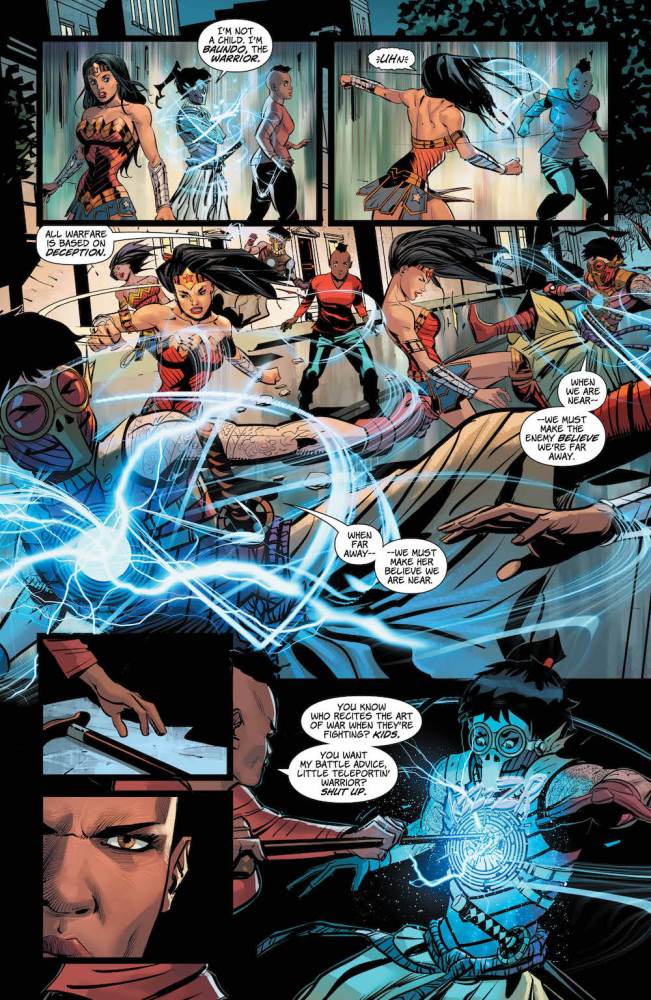
Corrina: So, the good part is that every action Diana takes fits who and what she is perfectly. She is a warrior, yes, but she chooses to fight only when all other options are exhausted. In this case, her concern that her blood could be used to cure people is perfect, because she’d always choose to help if she could.
However, I’m a little less thrilled with the mass fighting. It’s fun, in some ways, but it happens so fast that the villains never make much of an impression. You’d think at least one or two of this group would see Wonder Woman up close and think “nope, money’s not worth it.” But, still, my biggest problem is that the government is somehow the villain here? I hope that’s a fake-out of some sort.
Overall, it’s been a fun arc, especially for what’s essentially a fill-in, and I look forward to the conclusion more than, say, James Robinson’s upcoming takeover of the title, which I fear will focus on Wonder Woman’s brother and not Diana herself.
Disclaimer: GeekDad received these comics for review purposes.
